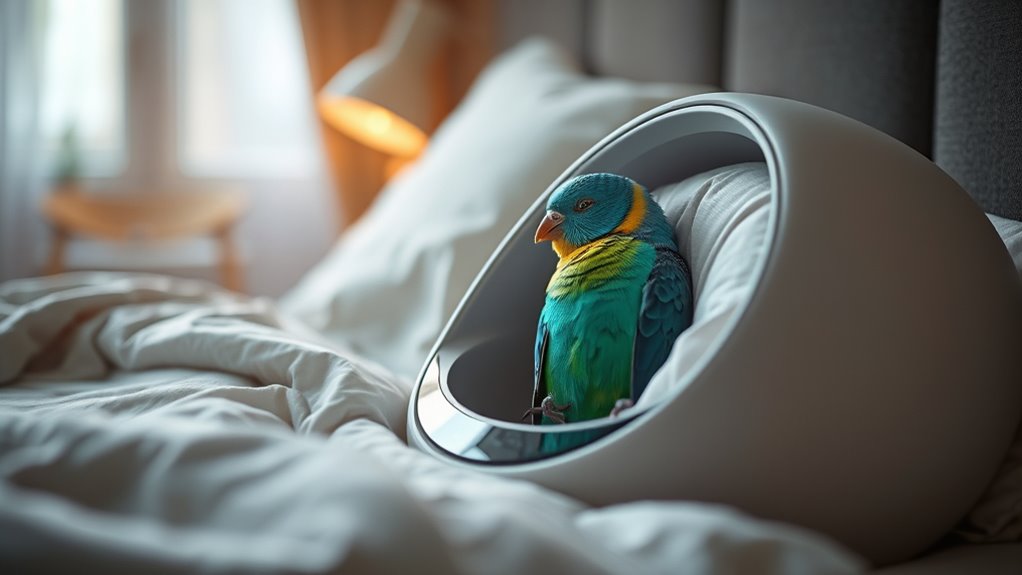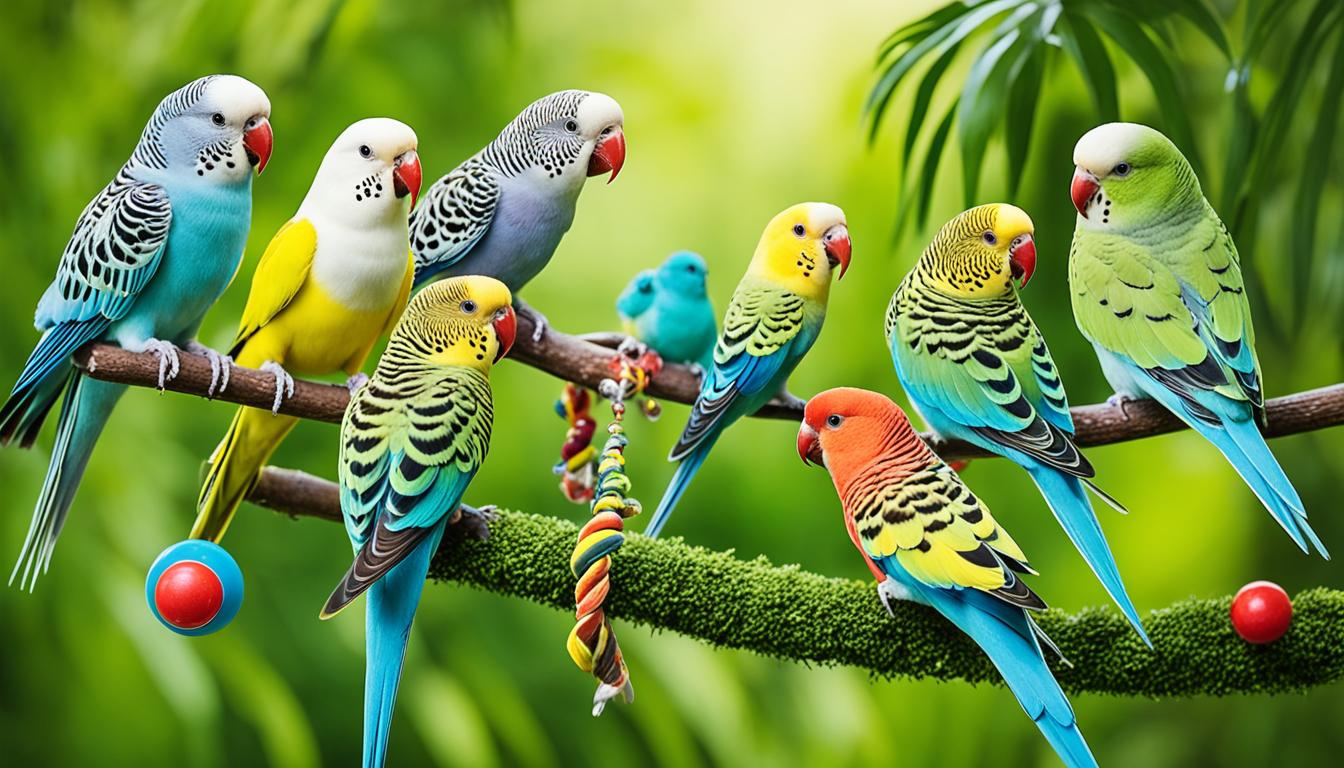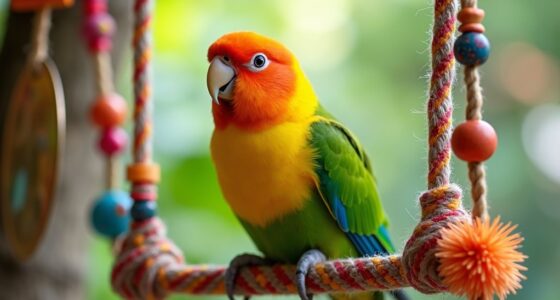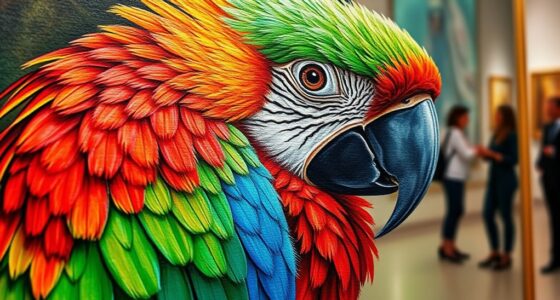Pet bird sleep trackers can reveal surprising bedtime rituals you might not notice, like preening, vocalizing, or specific movements before sleep. These subtle behaviors help you understand your bird’s natural winding-down routine and environmental needs. By monitoring sleep patterns and environmental factors, you can adjust lighting, noise, and routines for better rest. Staying aware of these rituals allows you to support your bird’s health, with more insights waiting if you continue exploring.
Key Takeaways
- Sleep trackers detect pre-sleep behaviors like preening, vocalizing, or nesting, revealing unique bedtime routines of different bird species.
- They uncover calming rituals that birds perform before bed, helping owners establish consistent and soothing bedtime environments.
- Data from trackers shows how external factors, like lighting or noise, influence bedtime habits and ritual quality.
- Revealed rituals can indicate stress or discomfort, prompting adjustments to improve sleep quality and feather health.
- Monitoring bedtime behaviors with sleep trackers enables personalized care to support natural sleep cycles and overall well-being.
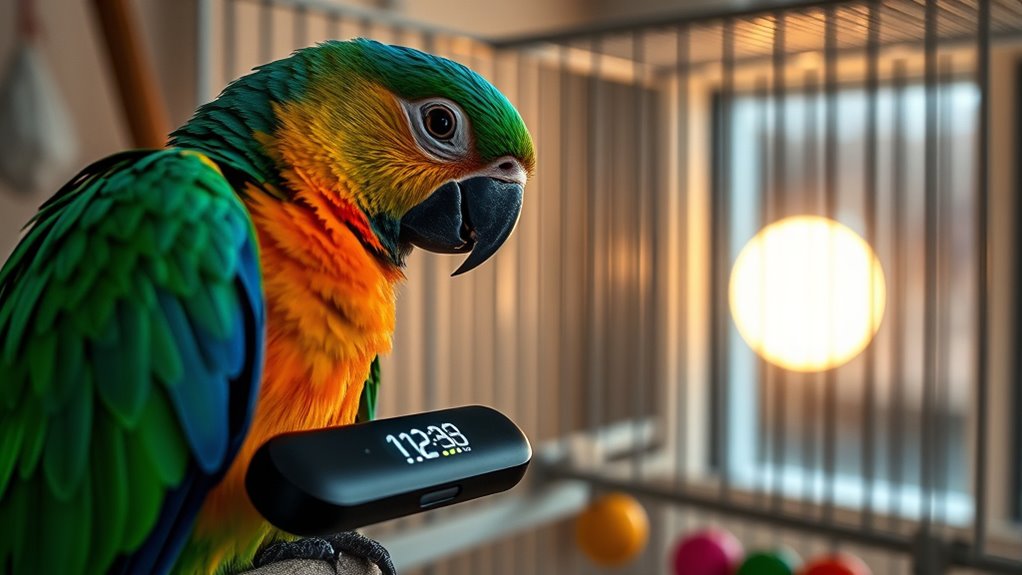
If you’re concerned about your pet bird’s health and well-being, sleep tracking can provide valuable insights. By monitoring your bird’s sleep patterns, you gain a clearer picture of their daily rest habits and overall health. Bird sleep patterns are essential indicators; changes or disruptions can hint at underlying issues, whether it’s stress, illness, or environmental factors. Sleep trackers help you identify whether your bird is getting enough rest or if there are irregularities worth investigating. Furthermore, these devices can reveal how your bird’s sleep aligns with their natural circadian rhythms, ensuring they follow a healthy sleep-wake cycle.
Monitoring your bird’s sleep reveals health and behavioral insights essential for their well-being.
One of the key benefits of tracking your bird’s sleep is understanding its impact on feather health. Feather condition is closely linked to overall well-being; poor sleep can lead to dull, frayed feathers or excessive preening, which may cause further feather damage. If you notice your bird’s feathers aren’t shining or seem unkempt, it could be a sign of sleep disturbance or stress. Sleep trackers enable you to detect patterns that might be contributing to feather issues—like early morning waking or irregular rest periods—so you can take steps to improve their environment or routines.
You might be surprised to learn that your bird’s bedtime rituals are more complex than they appear. Some birds have specific behaviors before settling down for sleep, such as preening their feathers meticulously or vocalizing softly. Sleep trackers can capture these subtle activities and help you understand your bird’s unique winding-down process. Recognizing these rituals allows you to create a more consistent and calming bedtime environment, which promotes better rest. For example, if your bird tends to preen excessively before sleep, you can ensure they’re in a quiet, dim space to facilitate a smoother transition to rest.
Tracking sleep also reveals how external factors influence your bird’s rest. Changes in lighting, noise, or even the presence of other pets can disrupt sleep patterns. By observing how your bird responds to these variables, you can modify their surroundings to foster a more restful environment. Ensuring a stable, dark, and quiet space helps reinforce their natural sleep cues, leading to healthier bird sleep patterns and, consequently, improved feather health. Additionally, understanding AI-driven diagnostics and other technological advancements can help monitor and maintain your bird’s health more effectively.
In essence, pet bird sleep trackers give you an inside look at your feathered friend’s nightly routines. They empower you to make informed decisions about their environment and care, ultimately supporting their physical health and emotional well-being. By paying attention to these subtle signals, you’re better equipped to keep your bird happy, healthy, and well-rested.
Frequently Asked Questions
Do All Bird Species Exhibit Similar Bedtime Rituals?
Not all bird species share the same bedtime rituals, but many do engage in avian socialization and feather grooming before sleeping. You might notice some birds huddling together or vocalizing as part of their nightly routine, while others focus on preening to keep their feathers in top condition. These behaviors help them relax and prepare for rest, though specific rituals can vary widely among different species.
How Do Sleep Trackers Distinguish Between Rest and Inactivity?
Imagine a vigilant lighthouse watching over the coast at night. Sleep trackers use motion detection and light sensitivity to tell rest from inactivity. When your bird remains still in darkness, the device recognizes it as sleep. However, if there’s slight movement or ambient light changes, it prompts the tracker to classify it as wakefulness. This way, the device accurately monitors your bird’s sleep patterns, just like a lighthouse guards the shoreline.
Can Sleep Habits Indicate Health Issues in Pet Birds?
You can often tell if your bird’s sleep patterns indicate health issues through careful health monitoring. Changes in sleep habits, such as excessive sleeping or trouble waking, might signal underlying problems. By tracking their sleep, you gain insights into their overall health. Sleep trackers help you notice irregularities early, so you can seek veterinary advice promptly, ensuring your pet bird stays healthy and happy.
Are There Recommended Sleep Durations for Different Bird Species?
You should aim for recommended sleep durations based on your bird’s species to support their avian circadian rhythms. Most birds need 10-12 hours of sleep, while some species require more or less. Ignoring these needs can lead to sleep deprivation effects, impacting their health and behavior. By understanding your bird’s specific sleep needs, you help prevent health issues and make sure they stay happy and active.
How Can Owners Improve Their Bird’S Sleep Environment?
Your bird’s sleep environment can be transformed from chaotic to cozy, like a sanctuary for a tiny feathered dreamer. Keep avian noise levels low during rest hours and guarantee cage lighting mimics natural day-night cycles. Covering the cage at night, using blackout curtains, or dimming lights helps signal bedtime, promoting better sleep. Creating a peaceful, dark, and quiet space helps your bird rest deeply and wake up happy.
Conclusion
Now that you know your pet bird’s bedtime rituals, you might be stunned to discover they’re more dramatic than a daytime soap! These sleep trackers reveal secrets so shocking, you’ll swear your feathered friend is secretly a nocturnal ninja plotting world domination. With every snooze, they’re living a double life—flying through dreams and maybe even binge-watching tiny bird TV! So, get ready to see your feathered pal in a whole new, hilariously epic light!
